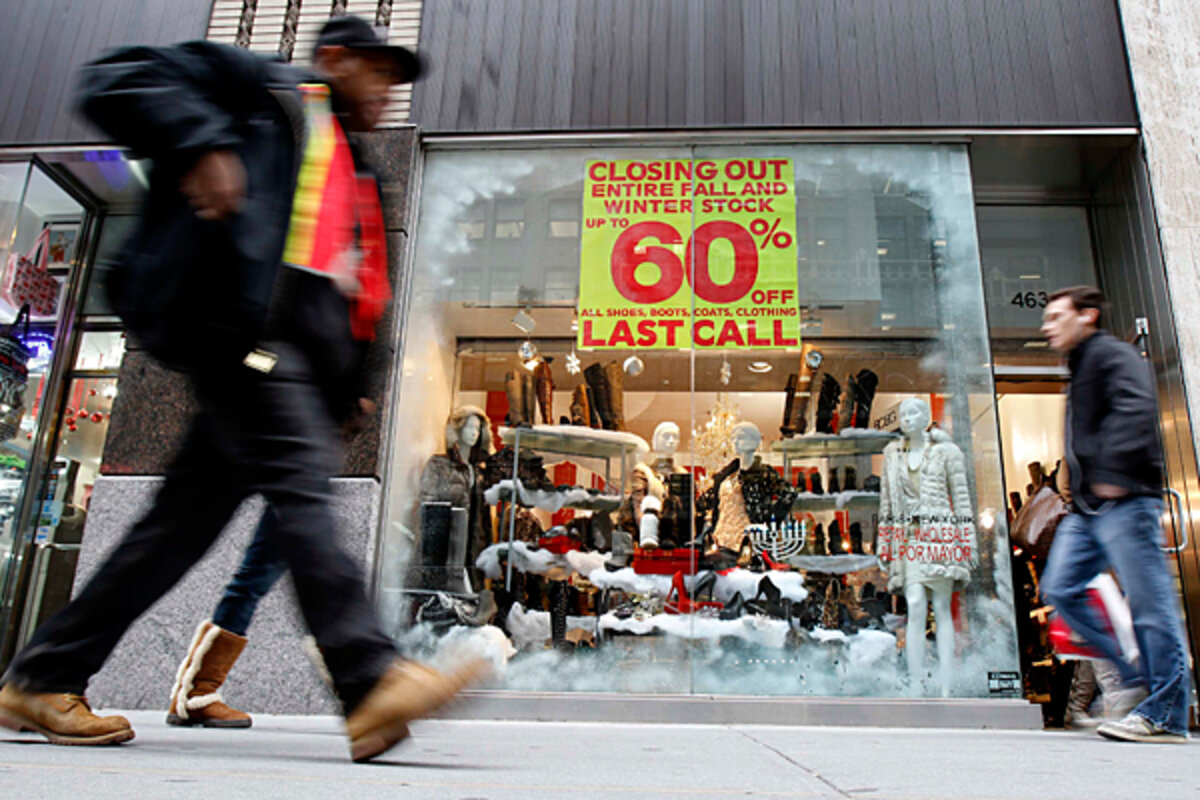Consumer spending is up: Are Americans enjoying a post-recession holiday?
Loading...
| Chicago
Consumers may be in a post-recession spending mood this Christmas season.
Spending is up in all retail categories compared with last year, according to MasterCard Advisors’ SpendingPulse, which tracks spending on all transactions including cash. Analysts say the increase in personal savings and a decline in consumer debt are giving consumers more confidence than they had in recent years to spend on others and even themselves.
“There is tremendous pent-up demand as consumers are tired of being afraid. So they’re seeing a little sunlight and a few more bucks in their pockets,” says Robin Lewis, an independent retail consultant based in New York City. “They’re willing to go out there and find a little treat for themselves.”
SpendingPulse tracked retail sales beginning Oct. 31 and continuing though Dec. 11. Online sales showed the greatest increase, 13 percent, from the same period last year. Another sign of success of online shopping: Compared with the previous year, online sales increased 18.3 percent on Cyber Monday, the first business day following Thanksgiving, and 17.2 percent that entire week.
Although online buying has not surpassed brick-and-mortar retail, the double-digit increases this season shows “consumers are getting more comfortable and confident with [online shopping], and [online retailers] are designing strategies to pull more people in,” says Mike Berry, director of industry research for SpendingPulse in St. Louis.
Incentives and free shippping
Helping to drive up online sales were early incentives, some offered before Thanksgiving, and free shipping. Retail operators like GroupOn.com, which allows consumers to collectively purchase goods or services at low rates, are examples of how shoppers turned to their computers to save money.
Apparel shopping increased 9.6 percent this season, with the increase in women’s apparel lagging behind men’s apparel sales, 4.4 percent to 8.4 percent. Jewelry revenue rose 2.6 percent and furniture rose 3.4 percent.
One reason apparel buying is up is because consumers had been holding onto their clothes for several years during the recession and now felt an impulse to refresh their wardrobe, says Mr. Berry. “Sales had been suffering for so long. Eventually you do have to buy new clothes. Kids wear out what they’ve got, or people are tired of what’s in their closet,” he says.
The one segment that’s flat is electronics, at just 0.4 percent higher than last year. While many more units were sold, deep discounting on big-ticket items like flat screen televisions brought down the average sales price, Berry says.
While the anxiety of spending during the holiday season seems to be lessening, some reasons may be because consumers have more to spend. According to the US Bureau of Economic Analysis, disposable personal income in the third quarter of 2010 rose 3.4 percent over the year before, to $11.4 trillion.
The increase in earnings means people are saving slightly more. Personal savings as a percentage of disposable personal income was 5.8 percent in the third quarter of 2010, compared with 5.6 percent the previous year.
Credit card debt down
Consumers are also chipping away at their credit card debt more than they had in the past. Outstanding consumer credit debt fell 4.4 percent in 2009 compared with the previous year, according to the Federal Reserve. The decline in debt continued steadily in 2010 through September, when it ticked back up by 0.6 percent. It rose another 1.7 percent in October. The increases are attributed to a combination of back-to-school and holiday spending, coupled with a lighter debt load, that is likely pushing consumers back to retail counters with more confidence.
“Consumers have begun consolidating their debt and paying it down a little. They’re still way overleveraged, but they have been paying their debt down, which makes them feel better,” says Mr. Lewis.
With four more shopping days until Christmas, the National Retail Federation says it expects a last-minute rush of spending. Last week the organization raised its holiday sales forecast, saying it expected a 3.3 percent increase in seasonal spending over last year’s $437 billion. The reasons are many: longer store hours, increased consumer confidence, better deals, and an enhanced shopping experience, such as pop-up retailing, which makes consumers feel excited to go out to the mall.
“Some of these retailers have really taken shopping experience to another level,” he says. “The traffic’s up and we are going to do much better than last year.”




